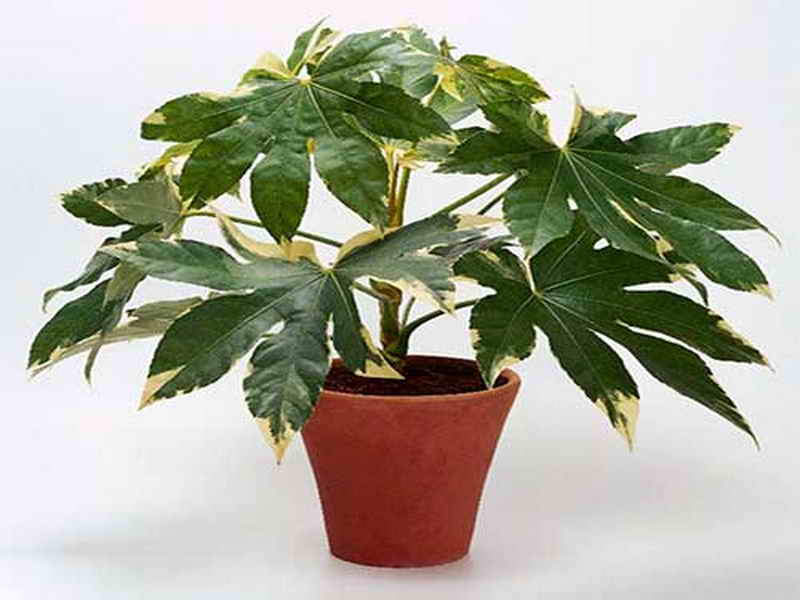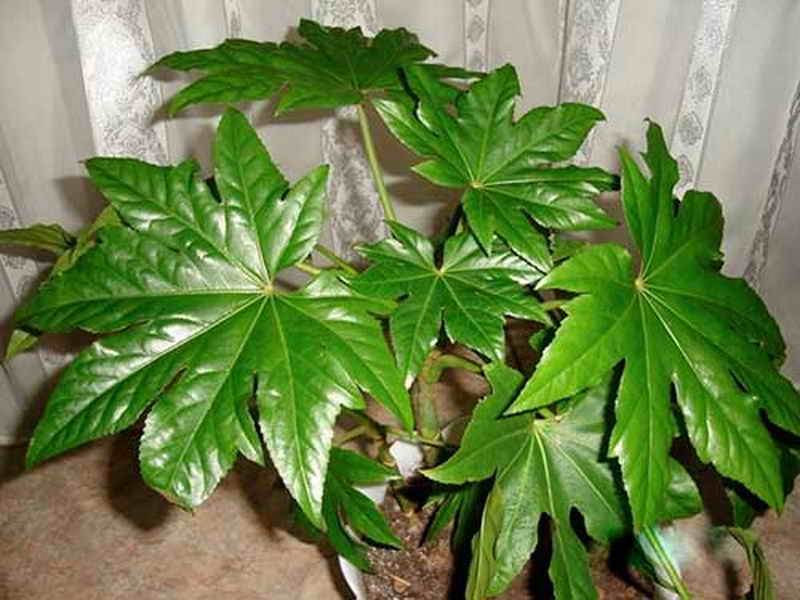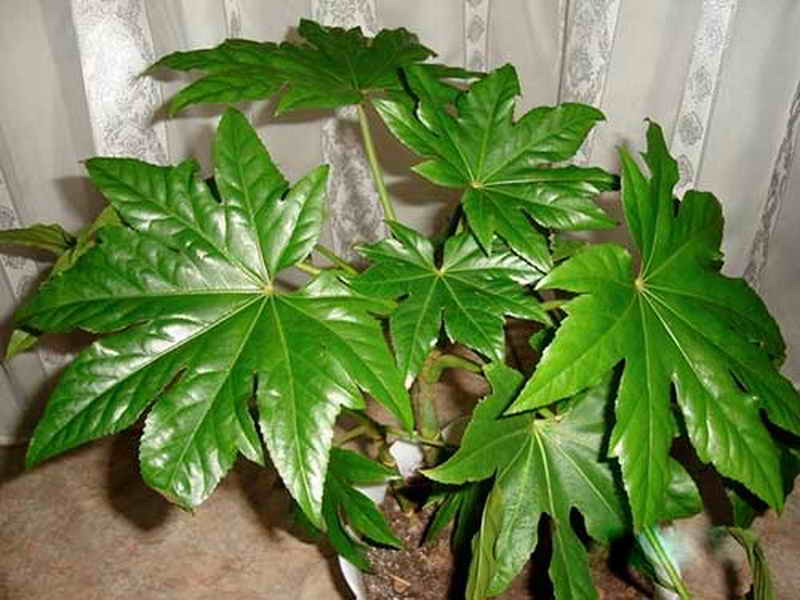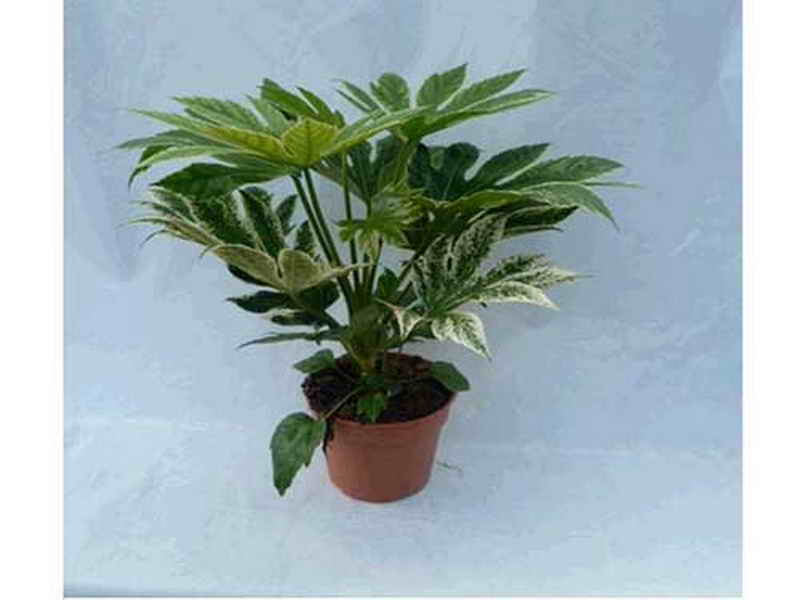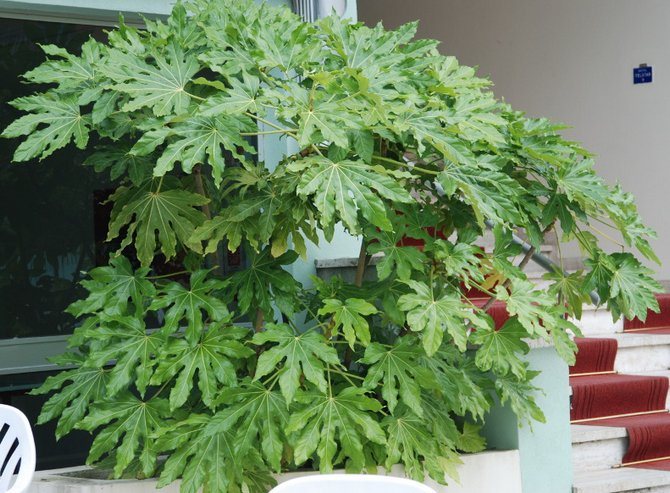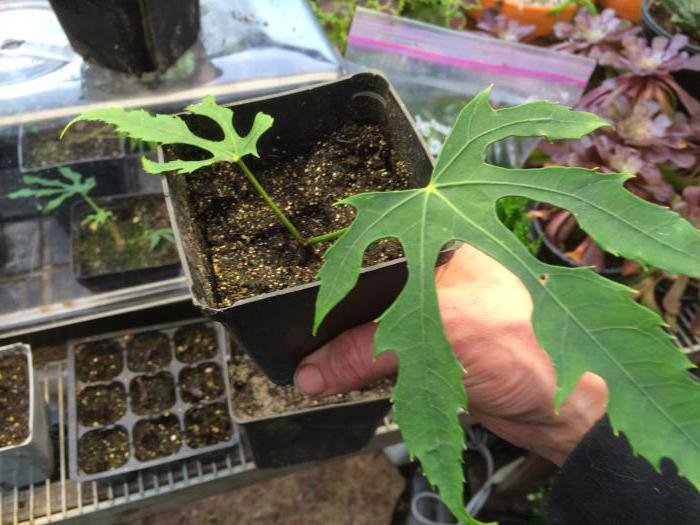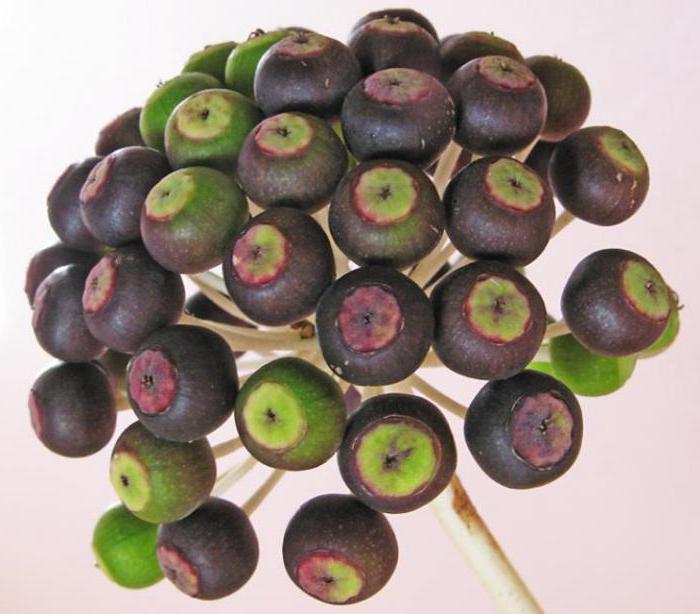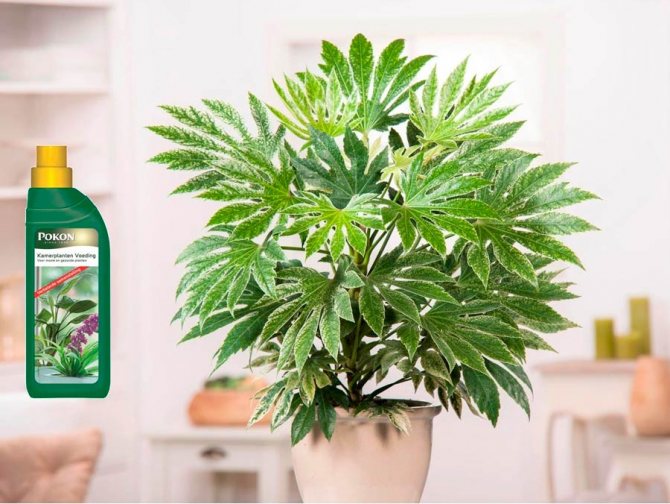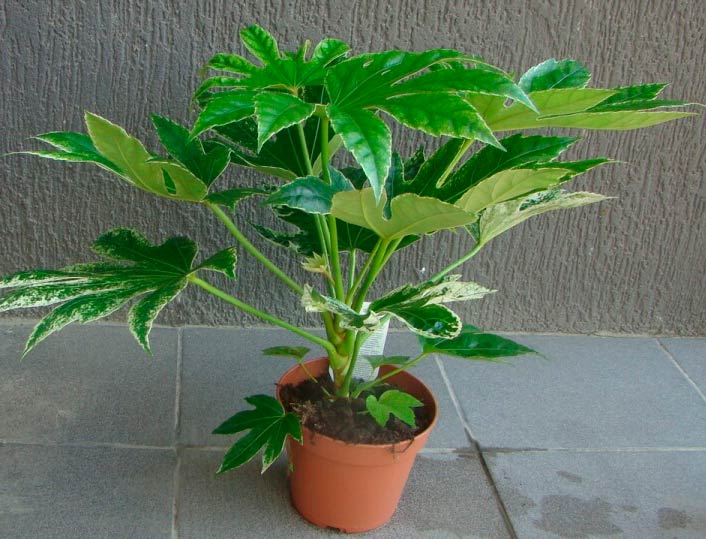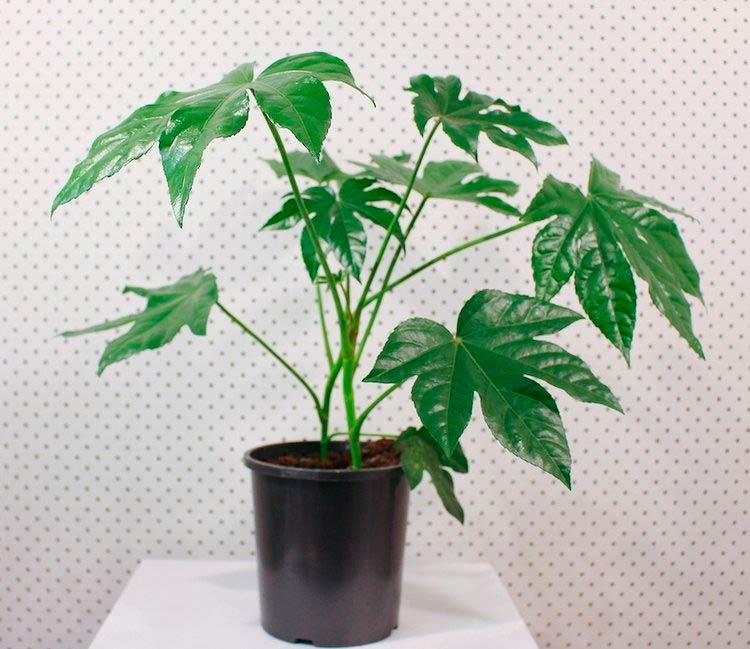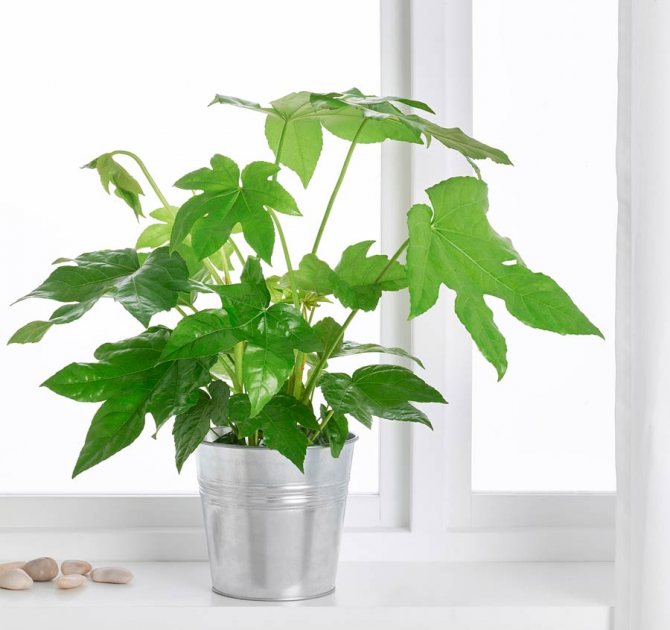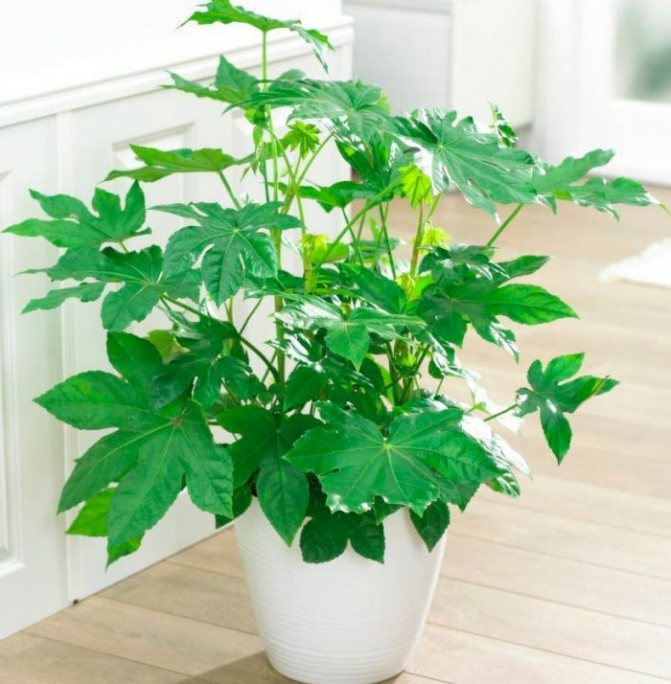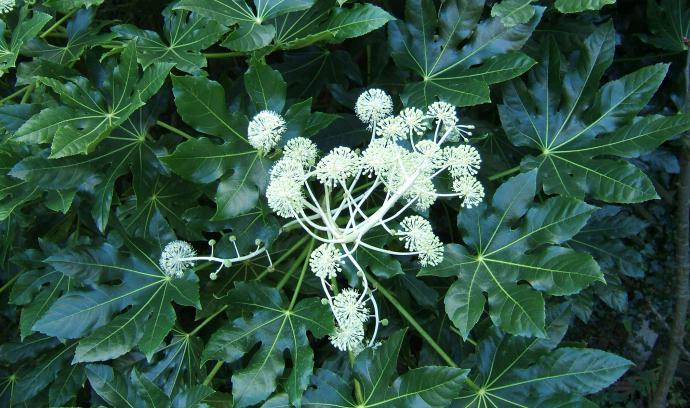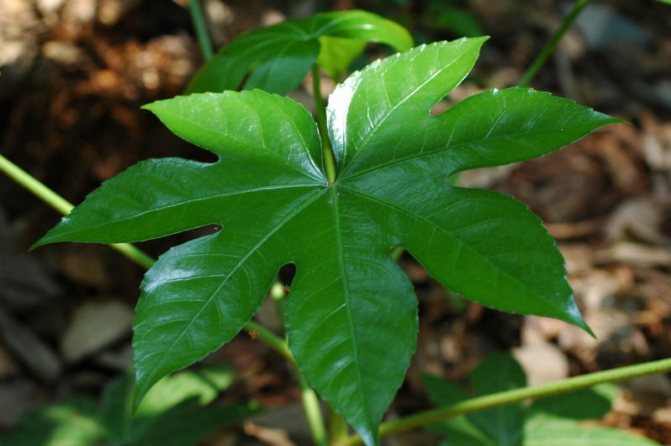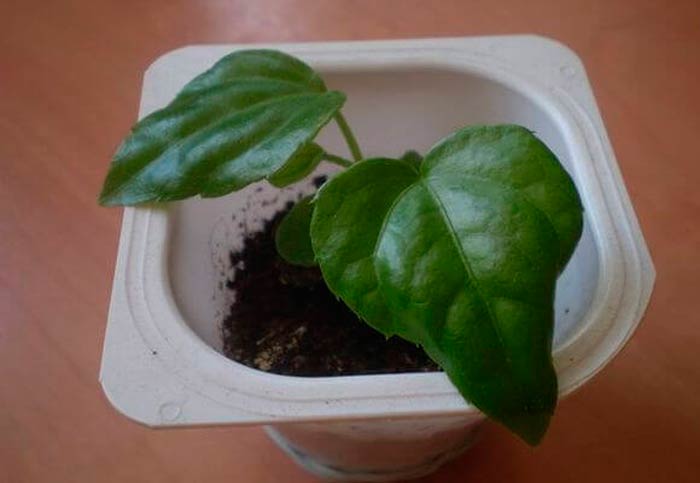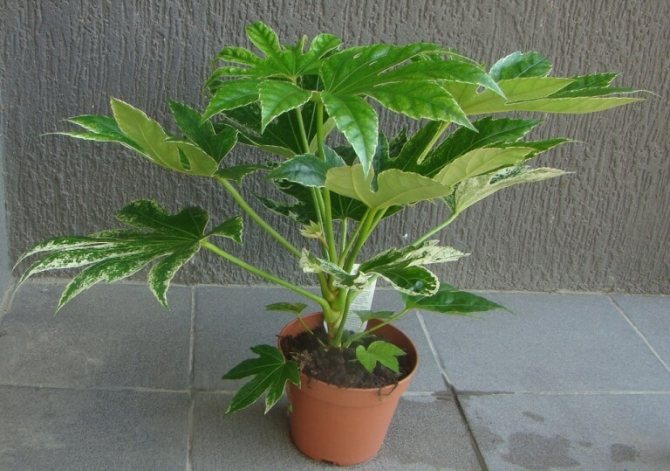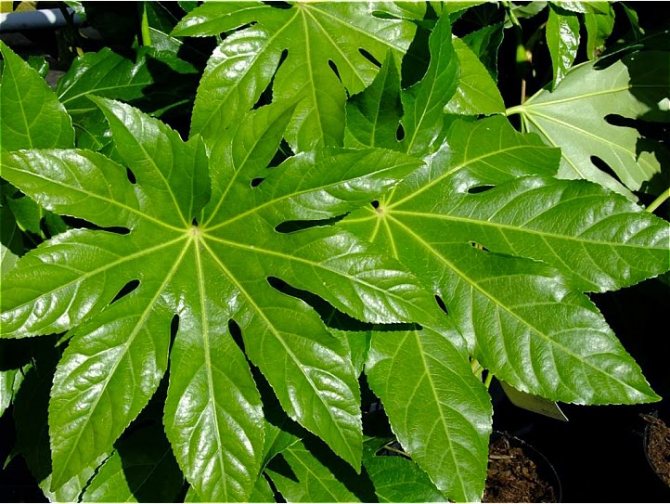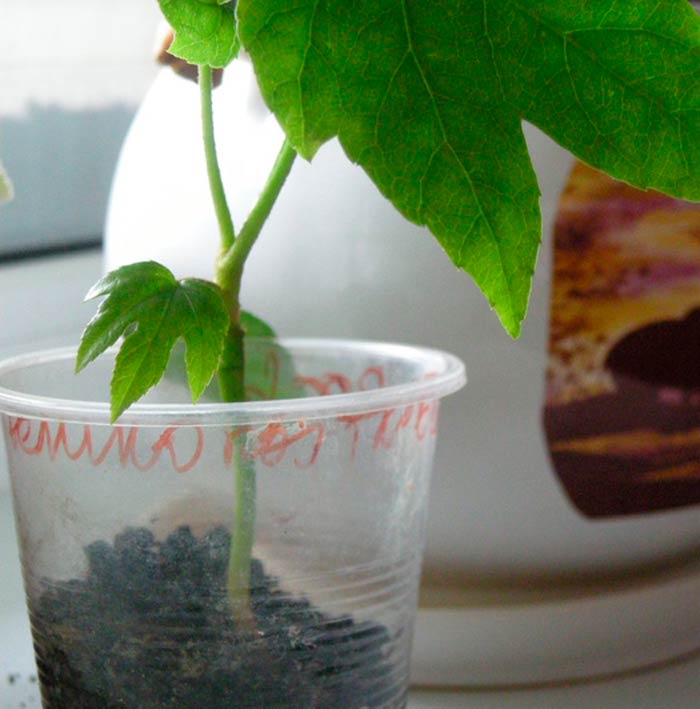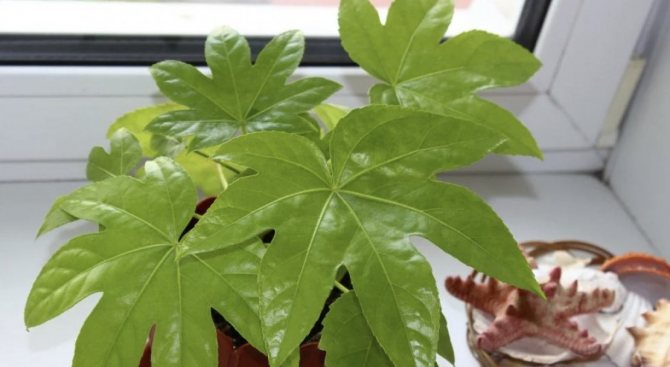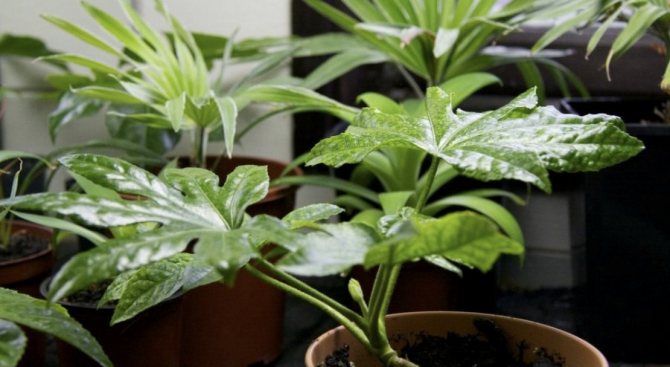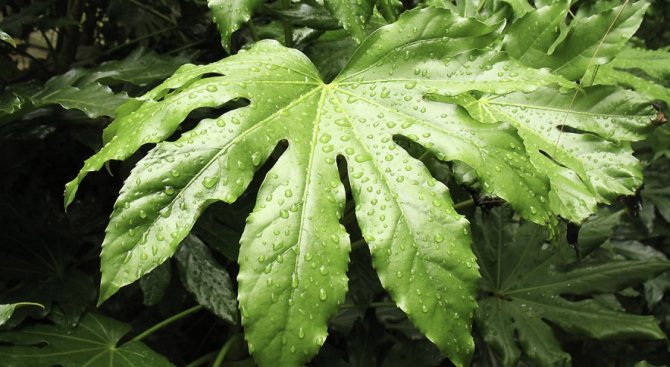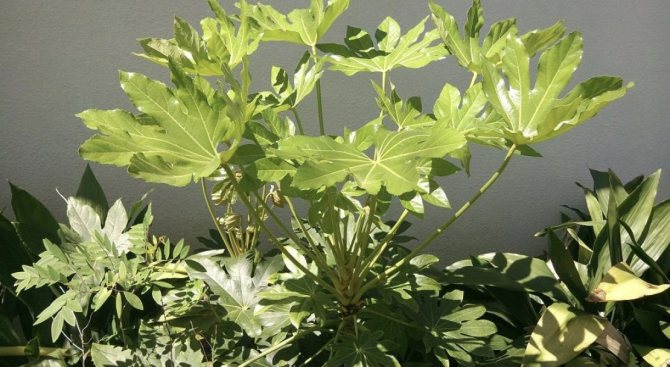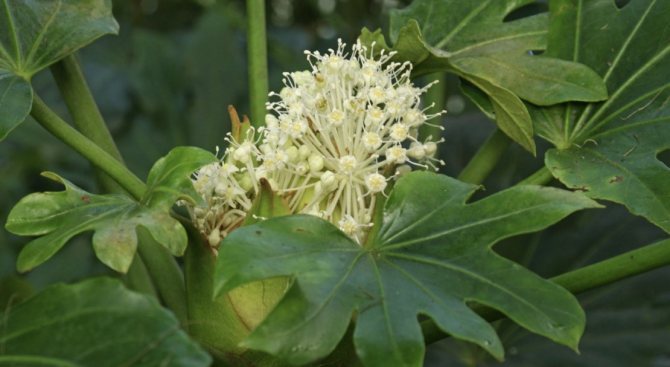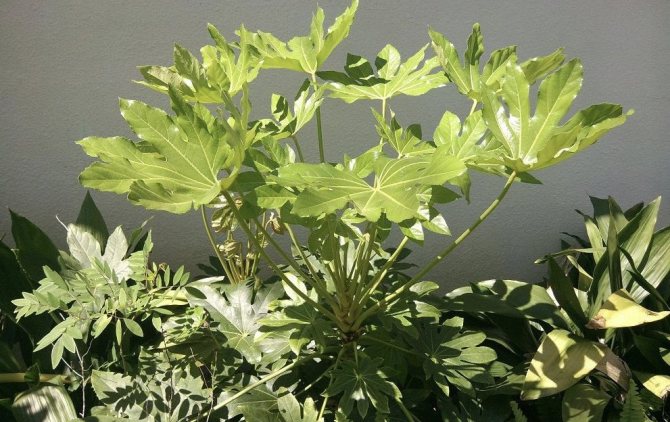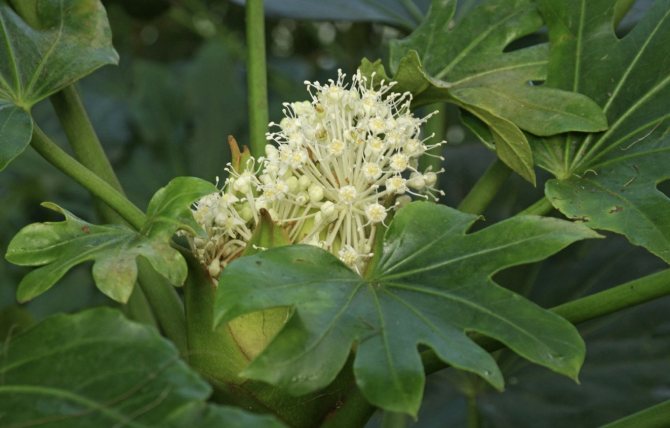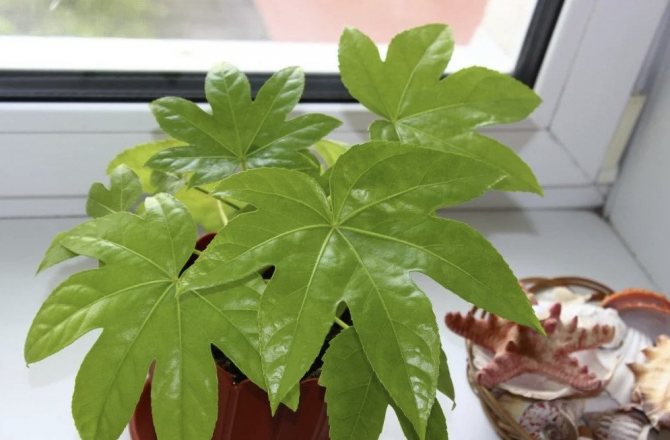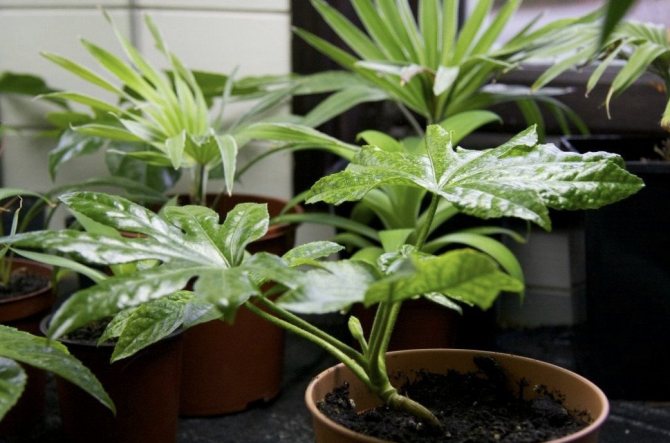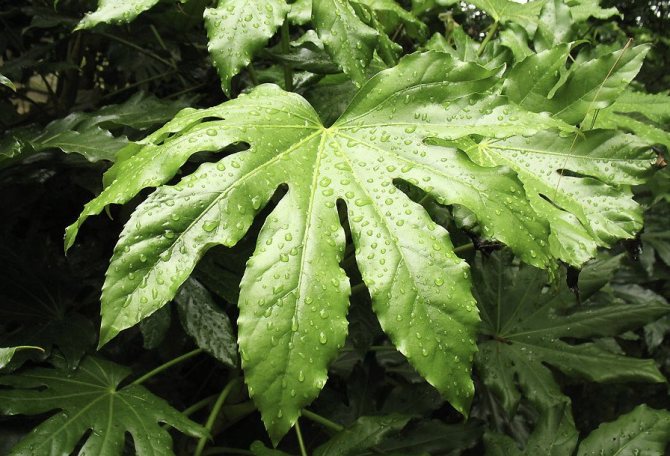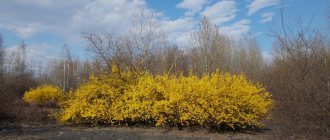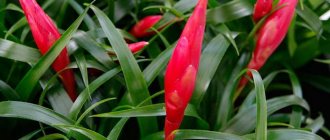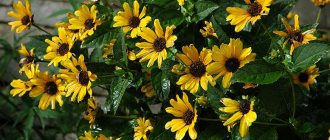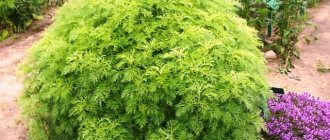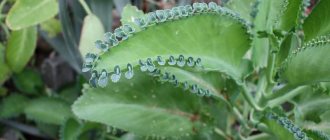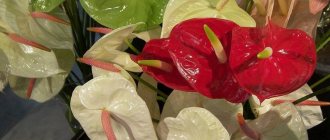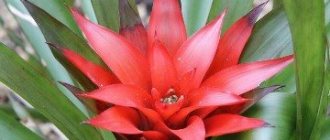Fatsia (Fatsia) is an oligotypic genus of plants that belongs to the family Aralievs (Araliaceae), which includes a small number of plant species. The scientific name of the genus was first used in 1854 by French botanists Joseph Déquinomy Jules Émile Planchon. It is derived from the Japanese name for the type species of the genus, Japanese Fatsia.
This plant has been known as an ornamental plant since Victorian times (19th century). It became widespread due to its unpretentiousness and rapid growth, which is easy to achieve with regular fertilization and timely transplantation. In a couple of years, Fatsia is able to grow 1 m in height from a very small specimen.
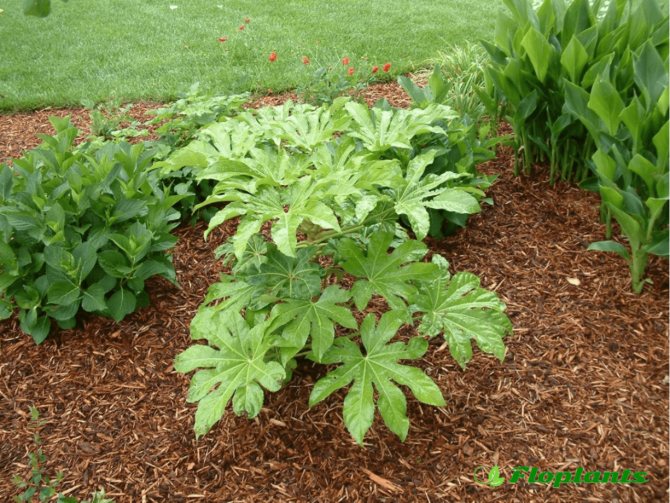
Fatsia is a low shrub with highly decorative leaves native to Japan, Taiwan and Vietnam, where it is widespread and can reach a height of 6 meters, forming a large spreading bush. In a home environment, Fatsia rarely overcomes the 1.5 meter barrier, but if you follow the basic rules for caring for a plant, then it will delight you not only with a lush bush with carved leaves, but also with flowering.
At home, Japanese Fatsia (Fatsia japonica) is mainly grown, but there are also garden species.
General characteristics of Fatsia
It is a woody plant with large leaves. Their width can sometimes reach 40 cm. The fatsia leaf is very original and beautiful due to its shape in the form of an open finger, and has a glossy, bright green color. The height of this representative of the flora in natural conditions is about 4 meters. Indoor flowers require a lot of free space, free arrangement, and only if these conditions are met can they please with a chic crown.
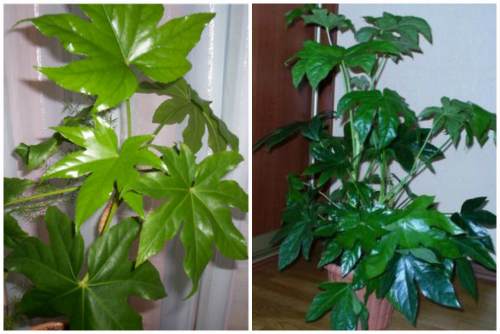

The plant belongs to the Araliaceae family and has a single pure species called Japanese fatsia, as well as several varieties (see the end of the article for their names and photos).
Brief information
Japanese Fatsia comes from the southern Japanese islands and South Korea, where it grows in real subtropical conditions. It is best suited for warm, humid summers, alternating with relatively cooler and drier periods. However, in a cold, draft or dry room, the plant will die. Indoors, the fatsia reaches 1.8 m in height, but its size can be limited by regular pruning. In the spring, the plant should be pruned significantly (if necessary, by half) and the tips should be pinched to stimulate branching.
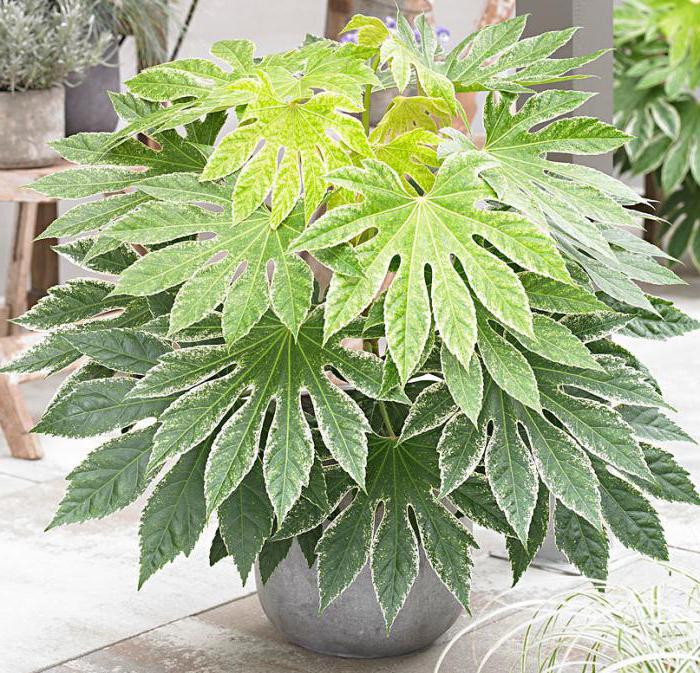

Lighting and location
- The green pet is very fond of bright, (not sunny), cool places with a regular supply of fresh air. The place should be slightly shaded, with diffused light;
- The excellent location of the bush is the western or eastern side of the house;
- The variegated Japanese beauty needs sunshine, and varieties with leaves of the same shade stand wonderfully in the shade;
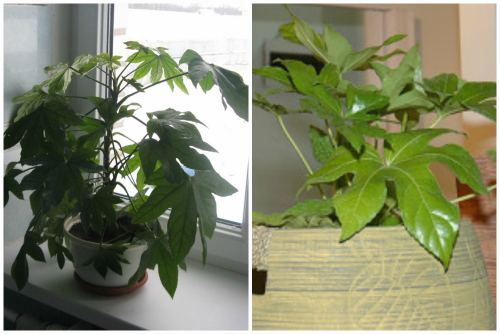

- In summer, an indoor flower can be placed outside, avoiding direct sunlight.
Home content
Japanese Fatsia is an unpretentious plant. Her favorite place is a bright room; therefore, it is preferable to install it on the east and west windows. But in hot weather, it is advisable to cover its leaves from the direct light of the sun.
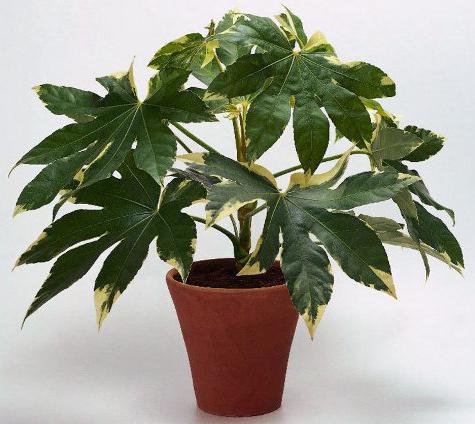

The best place for her is openwork partial shade. It is useful to take out fatsia in the shade in the summer. The plant responds well to fresh air.
The best air temperature for her is 18-22 ° C, since under such conditions the leaves of the fatsia retain their attractiveness.
In winter, this plant tolerates room temperature normally, but it is best to keep it under cooler conditions - 10-15 ° C. For variegated forms of fatsia, the temperature in winter should not be less than 16 ° C.
Air humidity and watering
- In the heat, the shrub should be watered abundantly with clean cool water. By the autumn period, the amount of water decreases;
- In winter, the "green dweller" is watered less frequently and kept cool;
- When several hours pass after moistening the soil, remove excess liquid from the pan, otherwise the roots of the bush will rot;
- If the soil dries up, the southerner may drop the leaves, and it will be extremely difficult to pick them up again. For this, special spacers are made and the leaves are tied up horizontally;
- Caring for fatsia at home means maintaining high humidity in the home. Spray the leaves with a spray bottle, if possible, do wet cleaning daily, wipe the leaves with a napkin.
P.S. We wrote here how to humidify the air in the room.
Japanese fatsia in the house: folk signs and superstitions
Fatsia Japanese looks great in the house, is associated with many signs and superstitions. It decorates the halls and foyers of administrative buildings, spacious offices and retail space, greenhouses. The lush bush is popular for its rapid growth, attractive appearance in the interior, undemanding care, similar to dracaena. Large finger-like leaves, which have various colors depending on the variety, perfectly clean the air in the home, filter out harmful volatile substances.
INTERESTING TO KNOW! Fatsia is influenced by Libra - the zodiac sign of the air. Therefore, it effectively eliminates the air space not only from toxins, but also negative energy.
As you will say, in the room where the fatsia is located, the atmosphere is cleared of accumulated heavy thoughts, harsh and nervous words, it becomes pleasant, airy light. The plant must be purchased in a home where the inhabitants often experience emotional problems, are in a bad mood, suffer from depression, see life in gloomy colors, do not see the meaning in the future, have no aspirations and hopes. It is recommended to start a fatsia for employees of offices and institutions, where visitors constantly come with a negative attitude, troubles, and accumulated problems. After all, a negative attitude accumulates in the room, begins to negatively affect employees, which is why discord begins in the team.
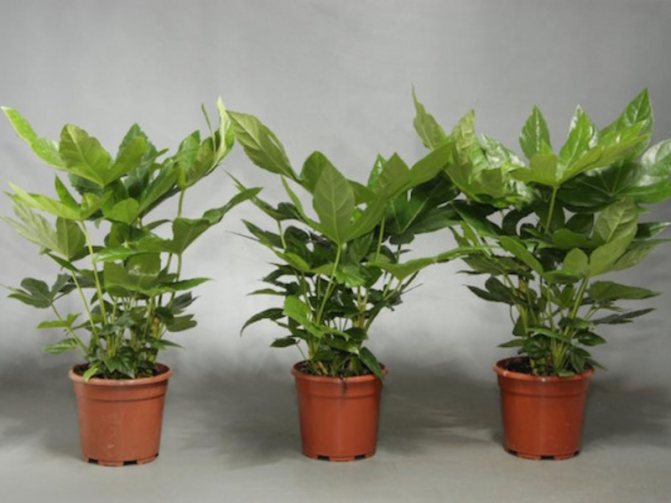

There are many positive signs associated with fatsia. Japanese bush:
- draws in bad energy accumulated from heavy thoughts and gloomy mood of people;
- protects from troubles, bad consequences associated with the negative mental impact of guests and visitors;
- eliminates the desire to conflict, argue, quarrel, punish children;
- fills the dwelling with a calm, conducive to pacification and benevolent relationships with energy;
- according to the omen, it improves marital relations, prevents quarrels, omissions, relieves fatigue of family members from each other, therefore it is called the "flower of family happiness";
- extinguishes sudden attacks of nervousness and irritability.
Ruled by Libra, a large flower with spreading foliage is able to correct the problems controlled by this zodiac sign regarding business and diplomatic relations. According to signs, the plant contributes to the acquisition of business acumen, helps a person build partnerships, present himself and his work in the best possible light.Therefore, it is recommended to put the "Japanese beauty" in offices and offices for employees who strive to speak competently and convincingly, to win partners and clients.
Transplanting and pruning an indoor flower
Fatsia is not difficult to care for because it easily tolerates formative pruning for a fuller crown. In a young "southern woman", when pruning, pinch the top. After some time, foliage will appear on the trunk, and new young shoots will appear near the base, which will later serve as cuttings for transplants.
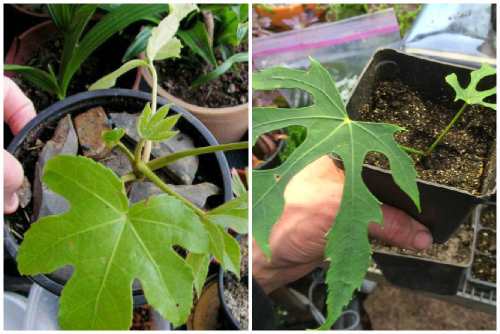

Home shrubs are transplanted every few years. The new container should be larger than the old one, because a tree plant can please you with young trunks. Fatsia is transplanted as follows: one third of the bottom of the pot is filled with broken shards and expanded clay, and a soil mixture is added to the rest of it.
Transfer
An adult plant is a shrub about 3 m high with large leaves. Young fatsia can be replanted annually, each time increasing the size of the flowerpot. At the same time, you can take cuttings for propagation and carefully trim the plant to stimulate dense, short growth. Once the shrub reaches its maximum height, it should be replanted after a year and pruned more aggressively. Older plants may need to trim their roots to keep them livelier and healthier.
Fatsia should be transplanted in the spring, when it outgrows the size of a flower pot. The container must be heavy to prevent tipping over as the plants can become quite heavy. In large specimens, it is sufficient to replace the top 5–7.5 cm of soil with fresh soil mixture. To prevent excessive soil moisture, which can cause root rot, the pot should have drainage holes. Fertilizers should be applied every 2 weeks in spring and summer in the form of a balanced liquid top dressing, diluted in half. The presence of yellow leaves indicates a lack of nitrogen.
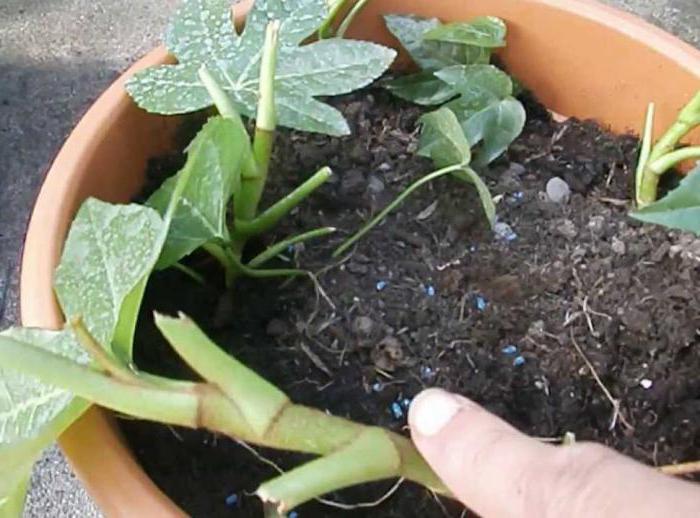

Cutting fatsia
- Reproduction by cuttings is carried out in the spring. Rooting at a temperature of 24-26 degrees in moist soil with diffused light occurs very quickly;
- Cuttings 10 cm tall should acquire some buds that are ready to grow;
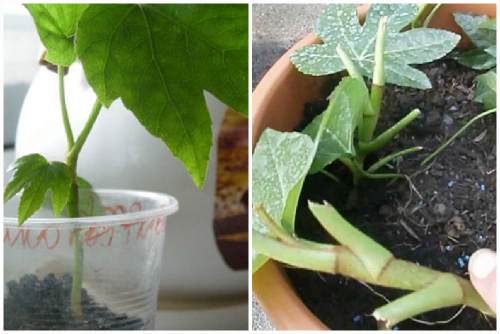

- Cover them with a glass jar or foil, and plant them one month later in the ground after rooting. With this method, voluminous, but small shrubs are formed.
Time relax
Provided there is sufficient light and humidity during the growing season, which is replaced by relative cold, Japanese fatsia is easy to care for. The dormant period is accompanied by a night temperature of 10 ° C or even slightly lower. Shrubs that have been briefly frozen will often recover when the ground warms up, but a hard freeze will surely kill them. Large and deeply divided leaves provide a wonderful backdrop for shade-loving subtropical plants, especially ferns. Due to its fleshy leaves, fatsia is vulnerable to pests including aphids, mealy beetles, bugs and whiteflies. If possible, infestation should be identified as early as possible and the affected area should be treated with an insecticide.
How to propagate fatsia by layering
When a flower is properly cared for, its trunk is abundantly covered with foliage. If it is exposed, the plant is rejuvenated using layering:
- In the spring season, the bark must be cut on the trunk cover;
- Wrap the incision with wet moss, which is dipped in a solution with fertilizers or in phytohormone;
- Roll up with foil;
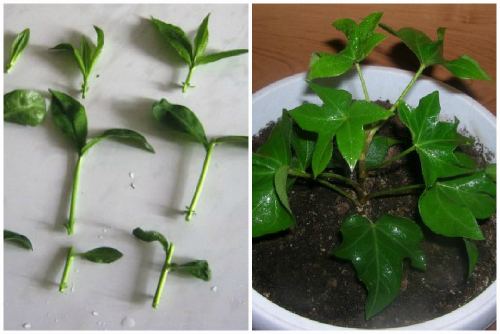

- Make sure that the moss is always moist;
- After a certain time, the first root will appear at the incision site;
- After that, after 2 months, cut off the top with roots and plant in a separate container;
- The top must be cut off slightly below the roots that appear.
Spraying
Spraying is very beneficial for the plant in hot, dry weather.For this procedure, you need to take only settled water, the temperature of which is 2-3 ° C higher than the ambient temperature. Also, to remove dust from the leaves, they must be gently wiped with a very soft cloth.
In winter, spraying of fatsia is not carried out, since the water on the leaves can provoke the development of a serious disease.
But if the plant is at room temperature, it can be sprayed once a week for hygienic purposes.
Seed propagation
Growing fatsia from seeds is a simple process:
- Place fresh seeds in the soil 10 mm deep. For these purposes, we take small boxes;
- Soil for seeds: leafy soil, sand and turf (1: 1: 1);
- We maintain the temperature regime of the earth and the surrounding airspace at a temperature of 18 degrees;
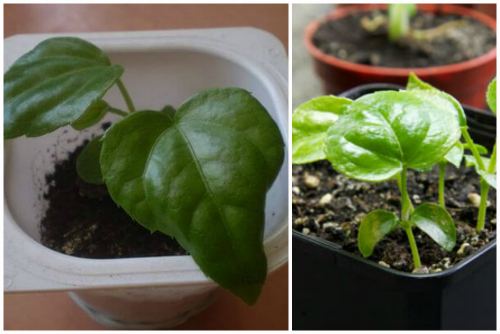

- Seedlings after germination are transplanted one by one into separate pots. Soil for sprouts: turf, humus, sand (2: 1: 1);
- We put the pots in a bright place.
Choosing a place for planting and preparing the soil
Fatsia needs some care and is located on the windows of the north direction. The summer rays of the sun burn the delicate foliage. Ugly yellow-brown spots appear on it, which do not heal and do not disappear over time.
The flower prefers to grow in fertile humus soil. If possible, it is best to compose a soil for it of its own manufacture, which will contain the following ingredients:
- Chernozem - 2 parts.
- Any purchased soil for decorative deciduous plants - 1 part.
- Sphagnum moss - 1/3 of one part.
IMPORTANT! All parts are mixed and disinfected in any way convenient for the grower. You can send it to the freezer of the refrigerator for a day, or you can fry it in the oven for 2 hours at a temperature of 200 degrees.
Pests and diseases of room fatsia
Pests that can damage a home flower: whitefly, mealybug, thrips, aphids, scale insects, spider mites.
- When they appear, the stem cover and leaves are treated by spraying with fungicides - 3 times, we take a break for a few minutes. The best effective way is to use Actellik;
- A simple soap solution, which is sprayed several times a day, will also help.
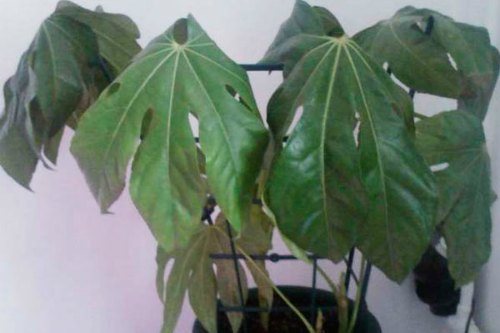

Ailments of the southern pet:
- Sunburn (a representative of the flora is in direct sunlight): its leaves become wrinkled. Treatment: it is necessary to increase the humidity of the air, to make a shade for the shrub;
- Lack of moisture: leaves break and dry. Treatment: abundant watering and "shower" every day in the summer;
- Excess moisture: drooping and soft foliage. How to help: do not water for several days, remove the liquid from the pallet;
- Gray rot (the flower is kept in a damp, cold place): the stem decays, which takes on a brown color. Treatment: put in a more ventilated room, remove damaged parts.
Temperature
Fatsia doesn't like heat. The optimum range for it is 17-21 ° C. If it is very hot in summer, you need to provide the plant with adequate watering and spraying, otherwise it may die.
Winter temperatures should not be very different from summer temperatures. Fatsia does not tolerate temperatures below 14 ° C... Variegated varieties are very thermophilic; for them, lowering the temperature even to 17 ° C is unacceptable.
Fatsia winters well in a heated city apartment. But it should be remembered that in the warmth the plant will grow intensively. To prevent it from stretching, it is recommended to use an artificial backlight.
Heat-loving Fatsia does not tolerate a sharp drop in temperature and cold drafts. When airing in winter, it is better to take the plant to another room.
Types of fatsia
- Fatsia Face (Lizei) - grows in the form of a bush, leaves cover the stems in a thick layer. The leafy, leathery plate is divided into 4-5 "lobes" of a dark emerald hue.The "green dweller" is winding and needs support;
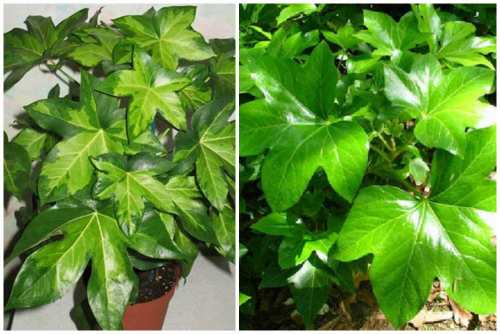

- Fatsia samurai - very similar to japonica, has leaf plates 30 cm in diameter, in the form of "lobes-lobes" with a glossy surface. The height barely reaches 1.5 meters. It blooms with fragrant fragrant flowers that have a whitish or greenish tint. The flowers are "umbrellas" and the fruits are small dark blue berries;
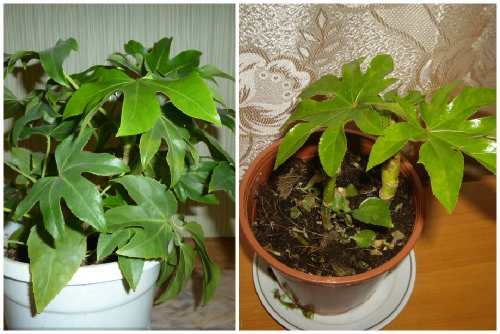

- Fatsia empire has too large, shiny glossy leaves, forming a dense crown of a tree in the form of a ball up to 40 cm in diameter. The height is measured at 1.5 meters and it rarely blooms;
- Fatsia japonica is another name for the aralia fatsia flower. It has the shape of a tree with a slightly branched trunk and light brownish bark. The shape of the leaves is rounded, divided into "lobes - fingers", parts of the leaves have a serrate edge and a broad-lanceolate shape.
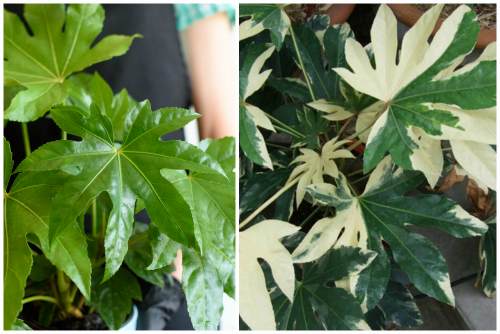

In floriculture, the most popular garden forms of Fatsia japonica:
- Miseri is a small, compact plant with rich green leaves;
- Aureimarginalis - the veins on the leaves have a yellowish tint;
- Fatsia variegata (Variegata) - in this shrub, the edges of the leaf plates are painted in a milky or white color.
You can buy fatsia in online flower shops. Its price depends on the height of the specimen and the diameter of the pot. For example, the cost of a plant with a height of 50 cm in a pot with a diameter of 17 cm will be about 750 rubles.
Professional advice
Japanese fatsia requires bright, but indirect light. You can use a north-facing window or place the plant 1–3 m away from a south, east, or west-facing window.
Water the bush until water seeps through the drain and the top of the soil remains slightly dry to the touch. The pot must be completely drained and should never be left in water. Do not water the plant if the soil is still damp from the previous watering, but you cannot allow it to dry completely.
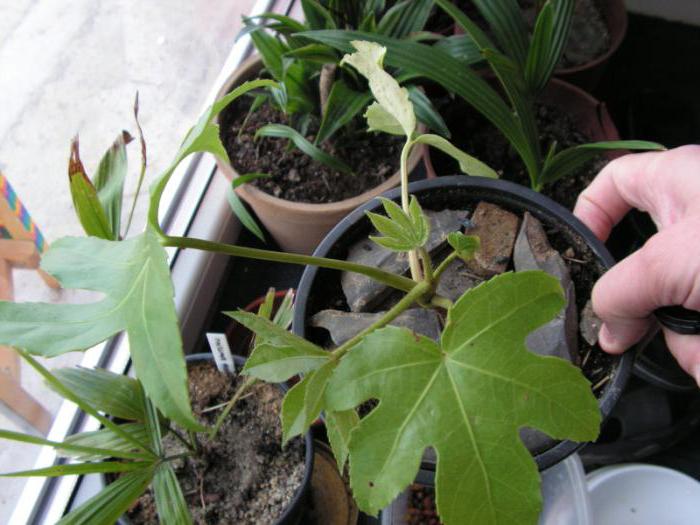

Fatsia should be in a relatively cool room, the daytime temperature in which is maintained in the range of 10-21 ° C, and the nighttime temperature - 10-16 ° C.
The plant should be fed with an aqueous solution of general-purpose fertilizer every 7-14 days in spring and summer, and during the winter months, food should be reduced. Dry fertilizers must be diluted in a ratio of 1 teaspoon to 7.5 liters of water. For more specific directions, refer to the manufacturer's instructions on the label.
Once or twice a month, the plant should be lightly sprayed with water to remove dust and keep the leaves shiny.
The growing tips of the Japanese Fatsia stalks must be pruned so that the bush does not look long and elongated, as this procedure will cause it to branch out, become thicker and remain compact. To avoid unsightly stumps, you should always cut the stems just above the leaf. Pruning can be done in two ways. The plant can be rejuvenated by causing dense branching by cutting the stems 60–90 cm in late winter before the start of the growing season. This helps to stimulate the growth of the leaves. Alternatively, up to 1/3 of individual stems are removed to the base anytime from late winter to late summer. Removing the oldest and tallest shoots keeps the plant small. The same method can be used to create a more open, sculpted or vertical shape.
Diseases
Most often, with an incorrect watering regime and inappropriate temperature conditions, gray rot affects fatsia. This fungal disease is manifested by the appearance of a gray coating on the leaves and shoots of the plant. The affected areas soften, the disease spreads throughout the plant.
To prevent the occurrence of this dangerous disease, you need to ensure that there is no waterlogging of the soil. Also, the plant cannot be kept at low temperatures. Usually, the removal of the affected parts saves the bush from death.
Pests willingly attack fatsia... Especially often it is parasitized by spider mites, thrips, mealybugs, whiteflies and aphids.
In order for the pests to not be able to multiply and harm the plant, you need to inspect the leaves and shoots daily. If insects are found, the aerial part of the bush must be treated with insecticidal preparations.
Where is the best place to place the plant?
Designers love the plant for its beauty and unpretentiousness. And if we take into account its cleansing psychoemotional properties, then it’s better not to come up with... Fatsia grows well not only on the windowsill and goes well with different styles.
Based on numerous signs, her they are eagerly placed in the halls of administrative premises, in offices, sales areas, greenhouses... Regardless of color, large feathery leaves of this plant take harmful impurities and negative energy from the air.
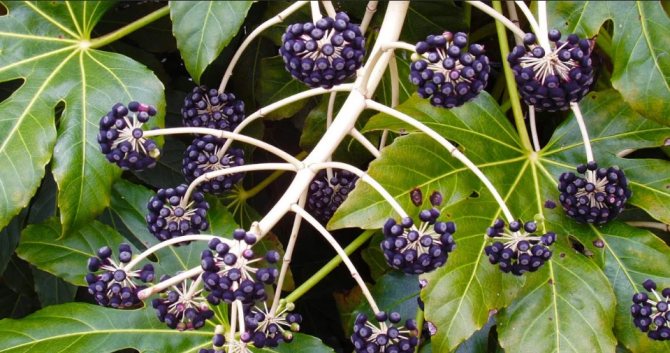

Some fears are caused by rumors about the poisonousness of the stems and leaves of the "Japanese". Actually the released juice, if anything, is dangerous, it is only an allergic reaction in a person or an animal. Some precaution will not hurt:
- pruning and transplanting a plant is best done with gloves;
- keep the cut bush away from children;
- handle withered flowers and emerging ovaries carefully.
Japanese Fatsia is a flower of family happiness. Its numerous varieties will perfectly fit into any style of home interior, cleanse the air of negative energy and improve the psycho-emotional climate in the house.
Subscribe to our Social Networks
Problems
Even with good care, sometimes problems arise in growing fatsia. Most often, her leaves turn yellow and fall. Sometimes it stops growing and slowly dies.
There can be several reasons for yellowing and loss of leaves.
Fatsia painfully reacts to cold drafts and a sudden drop in temperature.
In this case, the plant may lose most of its leaves. Also, do not forget about feeding. With a lack of nutrients, fatsia begins to shed foliage.
Slowing growth of fatsia can occur due to a cramped pot... If the roots of a plant cease to fit in it, it sharply slows down growth and loses old leaves, its shoots become bare.
Without regular transplantation into new soil, this plant will not be able to exist for a long time and will die.
Trim / Support / Garter
This is a necessary procedure, without which there will be no beautiful and lush fatsia bush. Fatsia is cut annually in early spring.
Old, dry and too thin branches are removed, healthy shoots are cut by 1/3. This stimulates the growth of new branches and the formation of a bush of the desired shape.
Young plants grown from cuttings or seeds should not be allowed to grow upward for a long time. The tops of the seedlings and cuttings are pinched. This allows you to get additional shoots from the root and side branches extending from the trunk.
Benefit and harm
Fatsia leaves contain many useful substances, alkaloids, essential oils. In folk medicine, they are often used as a stimulating and tonic agent that increases the body's immunity. The root of the plant is used in the treatment and prevention of diabetes.
At the same time, Fatsia juice is slightly toxic. In people with sensitive skin, it can cause an allergic reaction in the form of redness, itching or burning. We advise you to always work with the plant with rubber gloves, and after work - wash your hands with soap.
Care
For caring for fatsia, all the skills that the florist has acquired by growing other indoor crops will be useful, but there are a couple of important features.
Firstly, if you make a mistake with watering (under-supply or overdoing it), the branches and leaves will wither and you will not be able to return them to their previous life.
Secondly, if you are an inexperienced florist, start with variegated varieties - they are more resistant to unfavorable moments.
Priming
The soil is preferable light, loose. A good option is hydroponics. If you buy soil in a store, choose a versatile substrate.
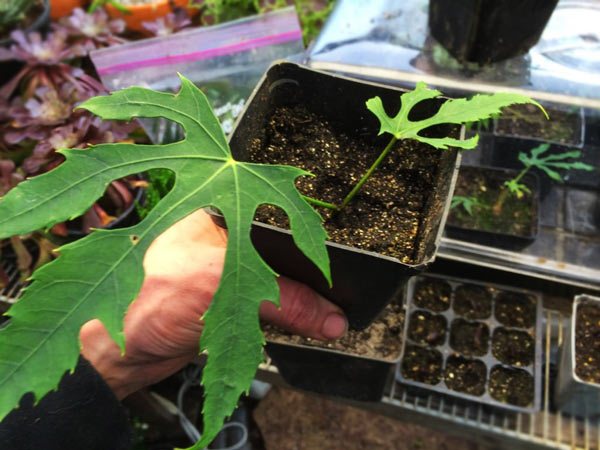

If cooking yourself, use turf soil (2 parts), leafy soil (1) and sand (one). Normal or slightly acidic acidity is desirable.
Watering and humidity
In watering for this flower, the main thing is stability.... It is useless to act in the ambulance mode, since the negative processes caused by improper watering are irreversible:
- due to a lack of moisture (even for a very short period of time), the leaves wither and fall;
- due to waterlogging - they lose their elasticity, gloss, turn yellow and fall off.
To avoid such situations, water the fatsia regularly. Between watering, control the condition of the soil - only the uppermost layer, 2-3 cm thick, should dry out.
In winter, if the plant remains at home, in a warm place, the frequency of watering should not be reduced, however, less water should be consumed so that not only the top layer of the soil dries out, but also part of the middle one.
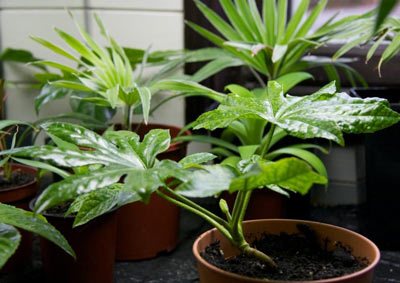

If the flower spends the winter in a cool room, the number of watering is reduced, but it is made sure that the soil still remains slightly damp.
Fatsia has less requirements for atmospheric moisture, however too dry air can adversely affect its decorative effect - it no longer looks fresh and juicy, the tips of its beautiful leaves begin to dry out.
The optimum humidity for a flower is at least 50 percent. This level can be maintained by spraying with water once a day or every two days.
IMPORTANT: wipe the leaves regularly with a damp cloth to keep them clean at all times - this promotes better breathing of the fatsia and protects against possible pests.
Lighting and temperature
Fatsia flower grows well in places with very different illumination.... Even in the shade, the leaves remain the same beautiful, shiny, but the growth of the flower itself slows down.
This is used by flower growers, removing plants that have already reached their optimal size away from the sun's rays. But who likes the light, it's variegated varieties, moreover, the more spots and stripes they have, the more they need sufficient illumination.
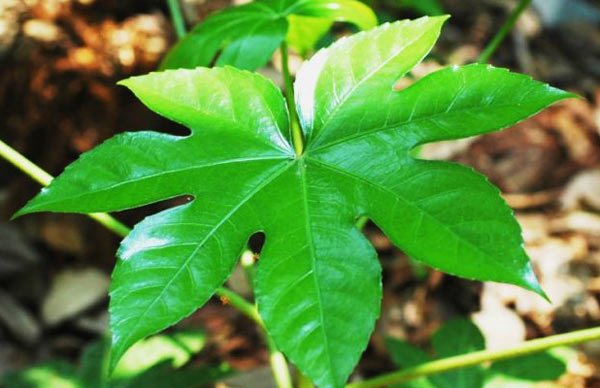

Fatsia can even cope with extreme in the form of direct sunlight - she will not get burned, as usually happens with other indoor plants. However, it is not worth subjecting the "Japanese woman" to this test - it weakens her, makes her depressed.
But this room culture has no complaints about artificial lighting, the main thing is that it is stable, even in the conditions of a short winter day.
Comfortable temperature range - from 18 to 23 degrees Celsius. It is desirable to maintain it during the period active for the flower - from the first days of spring to the end of autumn. In the phase of relative rest, the temperature should be 10-15 degrees.
And the fatsia desperately needs fresh air, for the sake of it she will even patiently endure a draft, especially in the summer.
Fertilizers
Fertilizers designed for decorative deciduous crops and containing a lot of nitrogen... Doses are those offered by the manufacturer, and the frequency of use is 1 time per 10 days. This scheme is relevant during the "active" period, from spring to October. In winter, feeding is not required at all, even if the "Japanese" is kept in normal household conditions.
Popular varieties of homemade fatsia with photos and names
The following varieties of this plant are most popular.
Fatsia Spider's Web
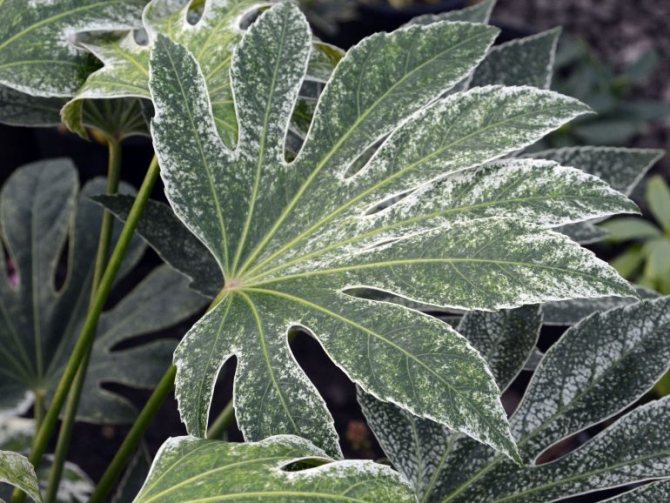

The leaves of a plant of this variety are bizarre in shape, with sharp tips. The color is uniform, with small blotches of a lighter shade.
Fatsia Variegata Variegata
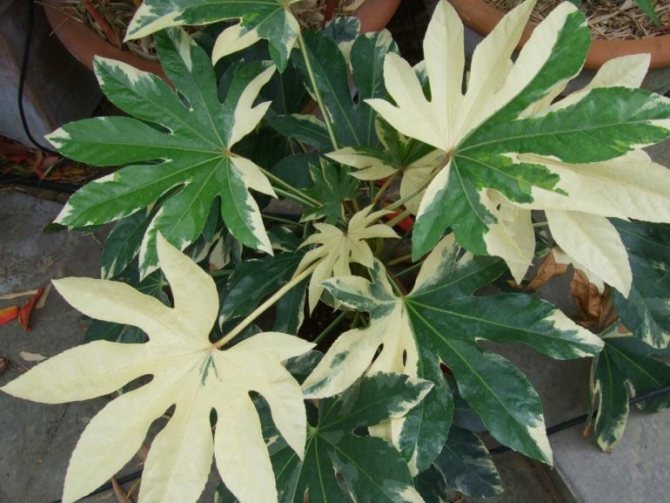

The leaves are like an outstretched palm, each tip like a finger. The dark green surface is complemented by a light border that colors the sheet unevenly: on one sheet there may be a lot of light, on the other - little.
Fatsia Aureimarginatis
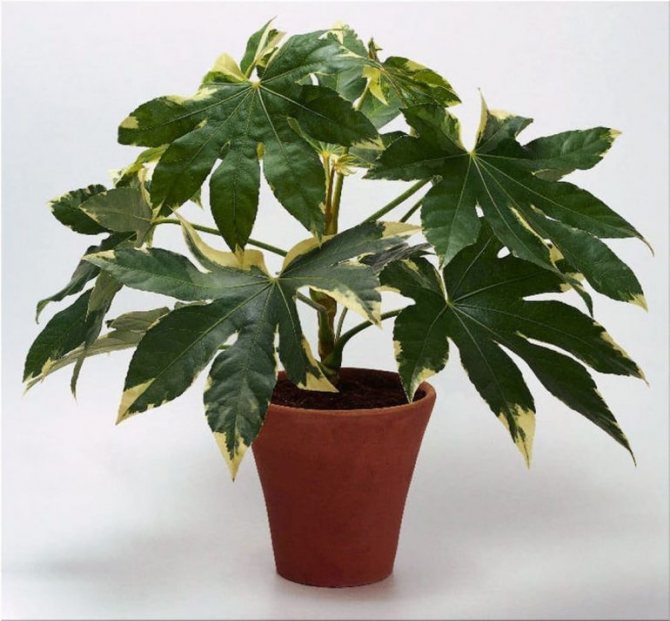

The shape of the leaves is similar to the previous variety, and the color is a pattern of a dark background and a light, bright yellow border.
Photo gallery
Japanese fatsia periodically blooms, although in indoor conditions this phenomenon is extremely rare. The flowers of the plant are small, bisexual, with expressionless petals, gather in umbellate inflorescences of greenish-white color. The flower does not represent decorative value, therefore some growers remove them.
After flowering, Fatsia produces fruits that look like spherical small berries with a diameter of about 0.5 cm. During the ripening period, they change color from green to dark blue, almost black with shiny skin. In rare cases, seeds in fruits are capable of ripening. If you strive with their help to engage in plant breeding, then the germination of the resulting material will be negligible.
Features of the
For this plant, fresh air is vital. The room where the bush grows must be regularly ventilated. But the flower should not be in a draft. In the summer, it is very useful to take the fatsia out into the open air. For her, you need to choose a windless place with good diffused lighting.
It should be remembered that fatsia juice is poisonous.
When poisonous juice gets on the skin, it causes burning sensation, irritation and allergies. Therefore, during all work with the plant, protective gloves must be worn.
For the same reason, the flower must be installed in a hard-to-reach place so that children and pets cannot get to it.
For the successful development of a plant, regular watering is important. Drying out of an earthen coma, even a short-term one, will inevitably end with the death of the flower. However, waterlogging is just as bad for him as drought.
This is one of the few shade-tolerant plants. Constant content in partial shade and even in the shade usually does not interfere with its correct development.

